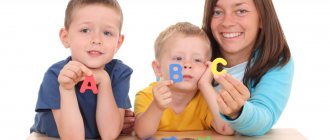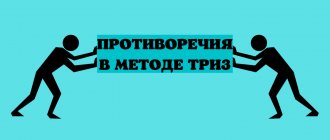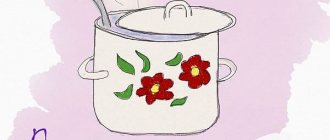Workshop for speech therapists and educators
Dear colleagues, I bring to your attention a workshop-seminar “Application of TRIZ technology in the development of speech of preschool children.” T-creativity, R-development, I-inventiveness. TRIZ technologies help develop flexibility and agility of thinking in a child; these are systems of games and activities that are designed to maximize the effectiveness of learning and development of preschoolers. You can use this material to conduct it within your preschool educational institution, as well as as an open city event. The seminar is compiled in the original author's style; educators, speech therapists, children of senior and preparatory groups can be invited to participate in it.
| Vinogradenko Irina Mikhailovna, teacher-speech therapist of the highest category, teacher-methodologist. |
Workshop for speech therapists and educators “Application of TRIZ technology in the development of speech in preschool children”
1. Organizational part “Friendly communication”
Psychology faculty
- Psychological training “Let’s get to know each other”
- Organization of creative laboratories
2. Main part “Use of TRIZ technology in the development of speech of preschool children”
Faculty of Development
- Blitz survey “In the land of literacy”
- Speech training “The Magic World of Words”
Faculty of Creativity
- Sample task “Draw a poem”
- Scheme of creative approach “Land of Opposites”
Faculty of Ingenuity
- Author's developments: “Funny Tables”
- Interactive approach to the development of coherent speech “Portrait”
3. Summing up the work
- A schematic “portrait” of the work of each creative laboratory.
- Conclusions of the Academic Council
- Feedback
Objectives of the workshop:
Teacher speech therapist:
— Dear colleagues, on the basis of kindergarten No. 18, the “Research Institute of Innovative Technologies for the Development of Speech Development in Preschool Children” is opening its work.
Like every research institute, the institute has its own scientific council , which is represented by:
Methodist of GROOO (full name)
Head of the methodological association of educators (full name)
Our research institute today employs experts: Educator-methodologist (full name) Educator-methodologist (full name) Teacher-speech therapist (full name)
Faculties of our institute:
- Faculty of Psychology - Faculty of Development - Faculty of Creativity - Faculty of Ingenuity
Methodological composition of faculties:
teacher-methodologist (full name) teacher (full name) music director (full name) music director (full name) teacher-speech therapist of the highest category, teacher-methodologist Vinogradenko I.M.
All workshop participants will conduct their research work in creative laboratories, which will be organized later.
Organizational part.
Teacher-speech therapist: - And now, friends, you will undergo training at the psychology department of our research institute. Let's get to know you. I invite everyone to stand up and form a circle. Colleagues, let's hold hands and give each other smiles, because a good mood today is the key to our success!
1. Psychological training “Let's get to know each other” is aimed at: establishing emotional contact between participants, creating a positive mood, overcoming shyness, freeing oneself from negative emotions, and setting up the group to work together.
Speech therapist teacher: (brings in a magic casket with two locks and two keys to them)
— Let’s add a little magic to our wonderful mood: in front of us is a fabulous casket of knowledge with two locks and two keys, let’s try to open it. The first lock will open after we get to know each other better, so my name is Irina, your name? (the seminar participants say their names, after which the speech therapist opens the first lock)
- The second lock will open when you tell us why you are here? I'm here to inspire you to achieve new creative achievements in your speech work. And you? (the seminar participants talk about the purpose of their visit, after which the speech therapist opens the second lock)
— The magic casket of knowledge is open, and in it is this seven-flowered flower, which is the emblem of our seminar and represents our motto !
Develop! Develop! Get inspired! Inspire! Create! Be in love! Want to know everything! To become the best teacher!
Teacher speech therapist:
- And in order to become the best, you need to work creatively and efficiently, which we will do now, I suggest you organize several creative laboratories and choose names for them, today you are all researchers, I wish you pleasant, high-quality and interesting work (the seminar participants are divided into groups - creative laboratories).
— Dear colleagues, we are glad to see you as participants in the workshop, the topic of which is: “Use of TRIZ technology in the development of speech in preschool children.”
- So, friends, now you will take a course of study at the Faculty of Development. And our first laboratory work is called “In the Land of Literacy”, this is a quick survey that will help determine the general level of knowledge of our participants.
Main part.
Faculty of Development
Each researcher is given a blitz survey card.
Blitz survey “In the land of literacy”
1. Complete the sentences by choosing the right words: 1.1. We (what do we do?)… (hear and pronounce sounds) 1.2. We (what are we doing?) letters... (we see and write)
2. After the correct option put + (plus), after the incorrect one - (minus)
2.1 I put a hat on the doll. (-) 2.2 I dress the Natasha doll. (+) 2.3 I put a hat on the doll. (+) 2.4 I put a hat on the doll. (+) 2.5 I put a hat on the Natasha doll. (-)
3. Determine the last sound in words and write it in accordance with the rules of transcription:
3.1 cat...[t] 3.2 grandfather...[t] 3.3 horse...[n'] 3.4 pillar...[p] 3.5 mouse...[w] 3.6 skis...[s] 3.7 knife...[w] 3.8 tooth...[p]
4.Answer the questions.
4.1 Which sound never occurs in the position “at the beginning of a word”? ([s]) 4.2 How many vowel sounds are there in the Russian language? (6) 4.3 What sounds are not soft? (sh, zh, ts) 4.4 Which letters are not indicated by sounds? (ь, ъ) 4.5 Name the hissing sounds (sh, zh, sh', h)
Teacher speech therapist:
— Dear scientific council! Your task today is to observe, evaluate, and draw conclusions. Your goal in this task is to identify the general level of knowledge of the audience.
A team of experts evaluates the participants' work.
Methodology of expert analysis: assessment based on the total number of questions, P – correct answers; H - partially correct answers; N - incorrect answers;
Expert conclusion: assessment of the general level of knowledge.
Teacher speech therapist:
— Dear researchers, I offer you a short speech training “The Magic World of Words.”
Speech training “The Magic World of Words”
1. Game: “Choose the word”
Labs receive cards with words and reference sounds.
Task: you need to choose words that are suitable for practicing the correct pronunciation of the specified sound (put +) and explain your choice.
| With Catfish + Mustache + Kissel – (soft sound) Bowl + Goat – (sound [z]) Sasha + Glass + Braid + Dog + Nose + Strength – (soft sound) Dog + | Z Zoya + Winter - (soft sound) Bunny + Goat + Catfish - (sound [s]) Watermelon - (the sound at the end of the word is deafened) Birch - (the sound in the middle of the word is deafened) Teeth + Umbrella + Puzzles + |
| Ш Hat + Cat + Knife + (the sound at the end of the word is deafened) Wallet + Belly – (sound [zh]) Pants + Shower + Pate + Luggage + (the sound at the end of the word is deafened) | F Scissors + Fire + Leather + Knife - (the sound at the end of the word is deafened) Belly + Spoon - (the sound in the middle of the word is deafened) Bug + Zhenya + Swift - (the sound at the end of the word is deafened) |
| B Bank + Bots + Cube - (soft sound) Grandmother + Powder - (no sound [b]) Pillar - (the sound at the end of the word is deafened) White - (soft sound) Fisherman + Cabin - (soft sound) | D Can + Daughter + Dima - (soft sound) Smoke + Pond - (sound at the end of the word is deafened) Radio - (soft sound) Beard + Water - (soft sound) Rod - (sound at the end of the word is deafened) |
Expert assessment methodology: determining the number of correct answers for each laboratory; for the highest score assigned, the creative laboratory receives a sun, for the average – a flower, for the low – a gray cloud.
Teacher-speech therapist: - And now, friends, let's play wonderful interactive speech games - we will activate our speech and thinking.
2. Game: “Similar words.”
Task: match nouns to adjectives by association. There is a sweet word - candy, There is a quick word - rocket, There is a word with a window - carriage, There is a sour word - lemon! Now don’t yawn, pick your words word by word!
Quick words - (rocket, plane, tiger, eagle).
Sweet words – (sweets, cake, pastries, sugar).
Funny words - (holiday, clown, gift, music).
Task: name objects that simultaneously have two characteristics.
Bright yellow - (light, lemon, sun, cherry, lamp).
Sweet and light - (cotton wool, cherry, life, smell, victory).
Expert assessment methodology: determining the number of correct answers for each laboratory; for the highest score assigned, the creative laboratory receives a sun, for the average – a flower, for the low – a cloud.
3. Game: "Cat"
Task: choose as many verbs as possible for the noun.
| Mystery Yesterday I was a mouse-hunter, Quite a sour-cream-butter, Today I am a sofa-sleeper, Quite a pillow-blanketer. (cat) |
- What can a cat do? (run, jump, sleep, meow, sit, stand, bite, scratch, eat, drink, hiss, purr, hunt, shake off, wash, tumble, swim)
Task: choose a noun by association.
Researchers make a figurine out of their fingers - a cat.
Cat:
from fingers - ...a figurine, from caramel, toffee - ...a candy, from clay, plasticine - ...a craft, from dough - ...cookies, from paper -...applique, from plush, rubber, plastic -...a toy, from threads -...embroidery, from a fairy tale -...a hero.
Expert assessment methodology: determining the number of correct answers for each laboratory; for the highest score assigned, the creative laboratory receives a sun, for the average - a flower, for the low - a cloud.
4. Game: “Brainstorm”
Assignment: why this happened, suggest versions.
— The owner was sitting on the grass during the harvest. Why did it happen?
(Tired, rested, had lunch, hid from the rain under an umbrella, sorted through the harvest, watched the sunrise, sunset, counted boxes, sharpened a shovel, repaired a bucket handle, called the customer on the phone, waited for the car).
5. Game: “Vocabulary Assault”
Task: choose nouns, verbs, adverbs.
| Children know this fruit, monkeys love to eat it. It comes from hot countries. Banana grows in the tropics. Tell me about me. |
- How did I get into the house? (bought, gifted, treated). What am I? (yellow, long, soft, sweet, aromatic, tasty). What can I do? (grow, ripen, turn yellow, fall, lie, rot). What can you do with me? (buy, wash, peel, cut, dry, eat, package, weigh, give). Who loves me most? (children, adults, monkeys, flies, wasps). What do I love most? (sun, breeze, rain). What subjects am I good with? (with water, knife, plate, vase, grater, pan, juicer, yogurt, ice cream, cake, pastry, candy, jam, juice, marmalade, drink). I look like? (delicious, wonderful, wonderful, magical).
Expert assessment methodology: determining the number of correct answers for each laboratory; for the highest score assigned, the creative laboratory receives a sun, for the average - a flower, for a low one - a cloud.
6. Game: “Polysemantic words.”
Labs receive cards with words that have multiple meanings.
Task: to prove the polysemy of words: pipe, star, needles, elastic band, frame, key.
Ambiguous words
| Pen | |||||
| Frame | |||||
| Needle | |||||
| Key | |||||
| Rubber | |||||
| Pipe | |||||
| Star | |||||
Expert assessment methodology: determining the number of correct answers for each laboratory; for the highest score assigned, the creative laboratory receives a sun, for the average - a flower, for the low - a cloud. Evaluation criteria: speed of reaction, correctness of answers, interesting solutions, original approach.
Teacher-speech therapist: - Our training at the Faculty of Development is completed, and I am transferring you to the Faculty of Creativity.
Faculty of Creativity
Assignment – sample “Draw a poem”
There are various techniques that allow you to develop a child’s ability to successfully memorize and reproduce texts, both prose and poetic. In all memory development techniques, the main thing is the use of support. Support is a visual-spatial model, the ability to encode text by using pictures, words, letters, symbols, pictograms, diagrams. The purpose of such coding, by correlating words from the text with the support, is to reproduce the given text as completely and accurately as possible.
But there is another goal - creating a zone of success in the child, that is, self-confidence, the ability to successfully perform such complex activities as storytelling. The reasons that the support allows you to better remember the text are as follows: - a given model helps to concentrate the child’s attention on the voluntary execution of the task of reproducing the text, and to plan this activity; - involving several analyzers in the perception of the text allows you to more fully use the child’s abilities in memorization; - choosing the right type of support helps to find a personally oriented way to solve the problem facing the child.
1. The support can be the actions that are mentioned in the poem, the so-called “tell poems with your hands” technique.
2. A plot picture that illustrates the poem can also serve as support.
3. The support can be a mnemonic table with pictures, symbols, pictograms reflecting the main words in a poem or text. Mnemonic tables are especially effective when learning poems. The point is this: for each word or small phrase a picture (image) is invented, thus the entire poem is sketched out schematically. After this, the child reproduces the entire poem from memory, using a graphic image.
Let's try, colleagues, to put this wonderful memorization method into practice.
Labs receive cards with poems.
Task: depict the poem in drawings, diagrams, pictograms, symbols for children to successfully and quickly memorize this poem.
We bought boots for the cat for the holiday. They combed her mustache and sewed new panties. Just how to put them on, the tail has nowhere to go
Ira asks: “Hedgehog, hedgehog, will you sew me a dress?” The hedgehog answered from under the tree: “There are no threads - only needles!”
At the market the hedgehog bought some boots. Boots for my feet, a little smaller for my wife, with buckles for my son, with clasps for my daughter, and put everything in a bag.
Expert assessment methodology: analysis of the presented drawings, diagrams, tables; for the highest score assigned, the creative laboratory receives a sun, for the average – a flower, for the low – a cloud.
Evaluation criteria: sufficient number of items, correct location, availability of graphic images.
Scheme of creative approach “Land of Opposites”
Speech therapist teacher: - Dear colleagues, today we want to introduce you to a diagram of a creative approach to the study of opposites. Before introducing children to contradictions, it is worth working on the very concept of “opposite.” It must be borne in mind that for children with speech development disorders, it is important first to act, and only then to express it verbally.
1. Draw the opposite: (color) a cheerful clown - a sad clown, a young tree - an old tree, winter - summer, night - day, etc.
2. Show the opposite: write - erase, take - give, greet - say goodbye, speak - remain silent, quarrel - make up, etc.
3. Touch the opposite: soft - hard, smooth - rough, rare - thick, fresh - stale, etc.
4. Lay out the opposites: on two areas of contrasting colors (black - red, black - white), children lay out pairs of pictures, toys, objects that have opposite properties, then explain their choice, games with throwing a ball from the teacher to the child and back.
5. Climb the ladder of opposites: for the exercise you need to have a flat ladder cut out of thick paper, 2 figures of men and a small paper flag. Children, naming opposite words, raise their little men up the steps of the stairs, passing each other a flag for each answer, and place a friendship flag in the middle at the top.
6. A journey to the fairyland of opposites can be the result of the work. Good and evil heroes, smart and stupid, live in the country, there is a clean stream and a dirty pond, a gloomy forest and a sunny meadow. At this level, children can also solve creative problems, for example: how to make a forest friendly, a pond clean, evil heroes good.
| You can compose a fairy tale using opposites yourself, or use already known ones, for example, “The Tale of the Old Woman Zavida.” It’s good to involve children in practical activities, for example, making a model of a fairyland out of sand. |
Speech therapist teacher: - Friends, we are moving to the “Ingenuity” department.
Faculty of Ingenuity
Speech therapist teacher: - I would like to introduce you to the author’s developments, the so-called “Fun Tables”, which help develop phonemic processes in a child. What games do you think can be played with such a table?
| Table: “Sound [k] |
| Tables: “Sound [z]” “Sound [z]” |
1. Author’s development for the development of phonemic hearing and sound analysis skills “Fun tables” - cardboard flat objects with pictures glued on the back side for a reference sound, for example: ball - [w], ship - [k], etc. Suggested games : “Find a common sound”, “Identify a reference sound with a voice”, “Name pictures with a reference sound”, “Determine the position of a sound in a word”, “Find objects in which a given sound is in a given position”, “Find words from 2- x, 3 syllables."
2. Interactive approach to the development of coherent speech “Portrait”
Speech therapist teacher: — Colleagues, one of the most difficult aspects of speech development is coherent speech. Ensuring that a child communicates not only freely, but also beautifully, is not easy. We use a variety of interactive methods for developing coherent speech, one of them is “Portraits of the Seasons,” which allows you to compose a story more fully, colorfully and expressively.
There are many things in nature and in our lives that always happen in a certain sequence and never happen otherwise. For example, the change of seasons. In our vernissage, each season presents its own portrait.
Here is a snowy crystal winter.
And this is a beautiful blooming spring.
Cheerful colorful summer.
And the golden sorceress autumn.
Speech therapist teacher: - In our vernissage, each season presents its own portrait. Guess where and whose portrait?
| So the days have become shorter, and the nights have become longer, Birds are stretching to the south, the forest and meadow have turned yellow. (Autumn) We are familiar with her threats. It threatens us all with frost. At least she wrapped herself in snow. Who is the terrible guest? (Winter) The beauty walks, touches the ground lightly, goes to the fields, to the river, and over snow and flowers. She comes with affection and her fairy tale. If he waves his magic wand, a snowdrop will bloom in the forest. (Spring) The forest is full of songs and screams, strawberries are splashing with juice, children are splashing in the river, bees are dancing on a flower. What is this time called? It's not hard to guess the bottom... (Summer) |
Spring Gallery
Spring has arrived - it's red! She herself is constantly changing and changing everything around her. Three young beauties awaken nature, warm the earth, and bloom with delicate colors.
Spring in March! - a gentle beauty who fights winter and defeats it. Icicles were hanging on the roofs, they were already dripping, drops were ringing, the sun appeared from behind the clouds.
| For a long time spring walked in secret from the winds and cold, and today it splashes straight through the puddles, drives away the melted snow with hubbub and ringing, to line the meadows with green velvet. Soon, soon it will be warm, - This news on the glass The willow drums on the glass with its gray paw. |
All the snowstorms have died down, And the frosts are not crackling. Drops dripped from the roofs, and icicles hung in a row. The March days have become more cheerful and warmer. In the park, square and alleys, thawed patches are already visible.
Spring is in April! - the sorceress, so timid, comes carefully, as if asking: “Can I?” And only then does it release a snowdrop, a green sprout, young grass, inflate the buds on the trees, and release light clouds into the sky. The sky is getting brighter, bluer, the sun is warming the earth stronger and stronger. And now the strict white and yellow daffodils, the children of the sun, are opening their petals.
| Birds are dancing in the air, The sun is kissing the sky, The familiar aroma of spring Drives away the slumber completely. In the thawed forest patches Warm days are a harbinger, The gift of spring has appeared - Primrose - snowdrop. Apparently you were born in a fairy tale, bloomed in the fields of a fairy, dressed up in white silk, and brought spring with you. |
Spring in May! – the most beautiful, brave, strong, joyful! The sun is getting brighter and hotter, fragrant lilies of the valley are blooming, slender tulips are burning scarlet. Multi-colored moths and cheerful bees circle over the flowers, collecting fragrant nectar. All nature is fragrant, singing, having fun, blooming and rejoicing!
| The month of May blooms and warms, The wind blows over the fields, The white lily of the valley blossoms, A moth flies over it. Striped, cheerful The first honey is carried by a bee, The meadows rustle with grass and the steep banks. The first thunder roared dully and crumbled into rain. Everyone sings, plays, dances. The month of May is coming. There is nothing brighter or more beautiful than it. Raise your hands to the sun! |
Summing up the work
A schematic “portrait” of the work of each creative laboratory.
Teacher-speech therapist: - Dear colleagues, you have completed a course of study at our research institute, and I suggest you evaluate your course of study using the typed evaluation symbols, make a picture of them and see how you worked today.
Researchers create a “portrait” from collected evaluation pictures – suns, clouds, flowers, and based on the resulting picture, they themselves evaluate their work.
Feedback.
All seminar participants receive paper larks, on which they are asked to write how this meeting was useful for them, to express their wishes and suggestions.
Conclusions of the Academic Council.
- Experts sum up the work of creative laboratories, evaluate knowledge, command of the native language, manifestation of a creative approach, activity, originality, speed of reaction, evaluate bold decisions and unconventional approaches.
- The Academic Council evaluates the content of the seminar, methods of delivery, and the work of the author.
Evaluation criteria: usefulness, variety, practicality, initiative, prospects.
Author of the material: teacher-speech therapist of the highest category, teacher-methodologist: Irina Mikhailovna Vinogradenko
Also on topic:
Plan for interaction between teachers and participants in the correctional pedagogical process
Today, figurative speech, rich in synonyms, additions and descriptions, in preschool children is a very rare phenomenon. many problems in children's speech .
- Monosyllabic speech consisting only of simple sentences. Inability to construct a common sentence grammatically correctly.
- Poverty of speech. Insufficient vocabulary.
- Use of non-literary words and expressions.
- Poor dialogical speech: the inability to formulate a question competently and clearly, or to construct a short or detailed answer.
- Inability to construct a monologue: for example, a plot or descriptive story on a proposed topic, retelling the text in your own words.
- Lack of logical justification for your statements and conclusions.
- Lack of speech culture skills: inability to use intonation, regulate voice volume and speech rate, etc.
- Poor diction.
It is impossible to judge the beginning of the personality development of a preschool child without assessing his speech development. In the mental development of a child, speech is of exceptional importance. The development of speech is associated with the formation of both the personality as a whole and all mental processes . Therefore, determining the directions and conditions for the development of speech in children are among the most important pedagogical tasks. The problem of speech development is one of the most pressing.
Half of preschool children have insufficiently developed skills in constructing a coherent statement. In addition, most children actively share their impressions of the events they experienced, but are reluctant to take on the task of writing stories on a given topic. Basically, this does not happen because the child’s knowledge on this issue is insufficient, but because he cannot formulate it into coherent speech statements.
When conducting a lesson, sometimes the teacher sees himself and the techniques, but does not see the child, that is, during the lesson we observe what one teacher says. The reasons are insufficient preparation for the lesson. When looking at a picture or having a conversation, you need to carefully think through the questions. The teacher’s speech culture also plays a very important role in the development of speech. The teacher’s speech must be clear, clear, complete, and grammatically correct. The speech includes various examples of speech etiquette.
When talking with others, we use speech as a means of conveying our thoughts. Speech is one of the main human needs and functions for us. It is through communication with other people that a person realizes himself as an individual.
Therefore, the development of coherent speech is the central task of children’s speech education. This is due, first of all, to its social significance and role in the formation of personality. It is in coherent speech that the main, communicative, function of language and speech is realized. Coherent speech is the highest form of speech and mental activity, which determines the level of speech and mental development of the child. Mastering coherent oral speech is the most important condition for successful preparation for school.
of preschool teachers
It became obvious that it was necessary to change the ways of interacting with preschoolers in order to raise a talented person who is able to think outside the box and look at the world around him.
One of such technologies can safely be called TRIZ - the theory of solving inventive problems . The founder of this technology is Genrikh Saulovich Altshuller.
The main objectives of TRIZ education for preschoolers are: the formation of coherent speech based on the activation of creative thinking for productive cognitive, research and inventive activity; development of creative abilities; formation of the qualities of a creative personality.
Thus, the use of adapted TRIZ methods in the process of speech development of preschool children contributes to:
— activation of children’s cognitive activity;
— creation of motivational guidelines for the manifestation of creativity;
- creating conditions for the development of the figurative side of children’s speech (enrichment of the vocabulary of evaluative vocabulary, words with figurative meaning, synonyms and antonyms);
-increasing the efficiency of mastering all language means.
The main task of an adult is to create such an emotional environment for making decisions so that children are not afraid to do things differently in creative tasks “as expected.” It is also important to clearly draw the line: there are didactic tasks where there is always a correct answer, where the insert must match the shape and size of the hole, and the hero must match his fairy tale. And there are creative tasks where, in principle, there are no correct answers, where there are only different possibilities that each author - both an adult and a child - uses as he wants.
Throughout preschool age, it is necessary to develop in children the ability to build a dialogue (ask, answer, explain, object, make a remark). To do this, you should use conversations with children on a wide variety of topics related to the child’s life in the family, kindergarten, his relationships with friends and adults, his interests and impressions. It is important to develop the ability to listen to your interlocutor, ask questions and answer depending on the context.
TRIZ for preschoolers is a system of collective games and activities. Designed not to change the main program, but to maximize its effectiveness.
The use of TRIZ will lead to the dynamics of development of speech, inventive ingenuity, creative imagination, and dialectical thinking in preschool children. Children not only develop imagination, they learn to think systematically, with an understanding of the processes taking place.
Using TRIZ in a child’s cognitive development
TRIZ is a technology that, as a universal toolkit, can be used in almost all types of activities (both educational and in games and routine moments). This allows us to form a unified, harmonious, scientifically based model of the world in the consciousness of a preschooler. A situation of success is created, the results of the decision are exchanged, the decision of one child activates the thought of another, expands the range of imagination, stimulates its development. Technology gives each child the opportunity to show their individuality and teaches preschoolers to think outside the box.
There are many methods in the TRIZ technology arsenal that have proven themselves in working with preschool children. The following TRIZ methods are used in kindergartens
— Brainstorming method. This is an operational method of solving a problem based on stimulating creative activity, in which participants in the discussion are asked to express as many possible solutions as possible, including the most fantastic ones. Then, from the total number of ideas expressed, the most successful ones are selected that can be used in practice.
— Directory method. The method allows us to largely solve the problem of teaching preschoolers creative storytelling.
— Method of focal objects. The essence of this method is to transfer the properties of one object or several to another. This method allows you not only to develop imagination, speech, fantasy, but also to control your thinking.
— Method “System analysis”. The method helps to consider the world in a system as a set of elements interconnected in a certain way, conveniently functioning with each other. Its goal is to determine the role and place of objects, and their interaction for each element.
— Method of morphological analysis. When working with preschoolers, this method is very effective for developing creative imagination, fantasy, and overcoming stereotypes. Its essence lies in combining different options for the characteristics of a certain object when creating a new image of this object.
— Method of substantiating new ideas “Goldfish”. The essence of the method is to divide situations into components (real and fantastic), followed by finding real manifestations of the fantastic component.
— MMC method (modeling with little people). This method is aimed at allowing children to clearly see and feel natural phenomena, the nature of the interaction of elements of objects and substances. It helps to form in children dialectical ideas about various objects and processes of living and inanimate nature. It also develops children's thinking, stimulates curiosity and creativity.
The essence of the MLM method is that it represents all objects and substances as consisting of many Little People (LM). In the understanding of us adults, these are molecules, but attention is not focused on this word; information is presented to children in the form of a fairy tale “Little Men”. It becomes clear to children that, depending on the state of the substance, Little People behave differently (in solids they hold hands tightly, in liquids they just stand nearby, in gases they are in constant motion).
— Thinking by analogy. Since analogy is the similarity of objects and phenomena according to some properties and characteristics, we must first teach children to determine the properties and characteristics of objects, teach them to compare and classify
— Typical techniques of fantasy (TPF). To help develop a child’s imagination, six wizards are brought in to help. The goal of wizards is to change the properties of an object. Magic techniques: increase-decrease, division-union, transformation of signs of time, revival-petrification, specialization-universalization, vice versa.
The TRIZ system in teaching children is practical help for a child to find the best solution to a given problem or situation. The principle is: “There is a problem - solve it yourself,” but not through trial and error, but through an algorithm of thinking that leads the child to the best solution.






